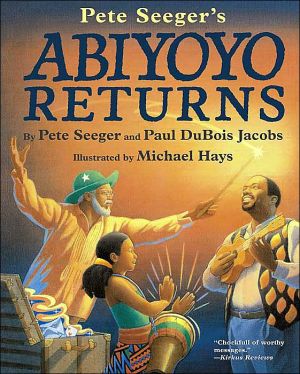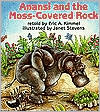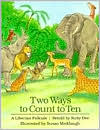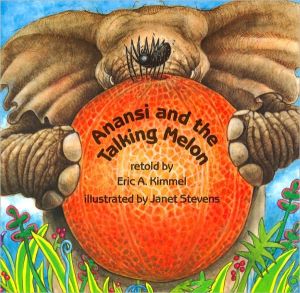Abiyoyo Returns
Thirty years later...\ The little town that was once threatened by the giant Abiyoyo has grown by leaps and bounds. But now that the townspeople have chopped down all their trees, every year they have floods and droughts. Worse yet, there's a giant boulder blocking up the site of their new dam! Something has to be done.\ Well, the young boy who helped make Abiyoyo disappear way back when now has a little girl of his own. And she knows the only way to save the town: Bring back Abiyoyo to help...
Search in google:
Thirty years later...The little town that was once threatened by the giant Abiyoyo has grown by leaps and bounds. But now that the townspeople have chopped down all their trees, every year they have floods and droughts. Worse yet, there's a giant boulder blocking up the site of their new dam! Something has to be done.Well, the young boy who helped make Abiyoyo disappear way back when now has a little girl of his own. And she knows the only way to save the town: Bring back Abiyoyo to help move the boulder. "Bring back Abiyoyo?" the townspeople cry. "The giant that eats people up?" But the little girl has a plan for that, too....Fifteen years after Pete Seeger's storysong "Abiyoyo" came to life as a picture book, his beloved giant is back in a wonderful new story. With Michael Hays's brilliant illustrations and a sing-along score included, Abiyoyo Returns is destined to become a family favorite.Children's LiteratureA once small town is growing by leaps and bounds. But there are terrible droughts and the people of the town decided they must build a dam. This work goes along very nicely until they hit a boulder. It is huge. No matter what they do, they cannot move that boulder. Then someone suggests, "Bring back Abiyoyo!" Abiyoyo is the giant with long fingernails and slobbering teeth who eats people. Everyone fears him, but certainly he can move that enormous boulder. The townspeople decide that feeding Abiyoyo will make him happy. Soon, he even learns to brush his teeth. So with Abiyoyo's help the village gets its dam and the people learn that sharing will tame the monstrous Abiyoyo. Michael Hays brilliant full-page illustrations bring to life the characters in this marvelous tall tale and add dimension to the text. Readers will enjoy this story by master storyteller and singer Pete Seeger. 2001, Simon and Schuster, $17.00. Ages 4 up. Reviewer:Sue Reichard
\ From Barnes & NoblePete Seeger's story-song "Abiyoyo" came to life as a picture book in 1986. His beloved giant makes his return in this this original story, featuring Michael Hays's brilliant illustrations and a sing-along score, which is sure to be as much of a classic as the first.\ \ \ \ \ Children's LiteratureA once small town is growing by leaps and bounds. But there are terrible droughts and the people of the town decided they must build a dam. This work goes along very nicely until they hit a boulder. It is huge. No matter what they do, they cannot move that boulder. Then someone suggests, "Bring back Abiyoyo!" Abiyoyo is the giant with long fingernails and slobbering teeth who eats people. Everyone fears him, but certainly he can move that enormous boulder. The townspeople decide that feeding Abiyoyo will make him happy. Soon, he even learns to brush his teeth. So with Abiyoyo's help the village gets its dam and the people learn that sharing will tame the monstrous Abiyoyo. Michael Hays brilliant full-page illustrations bring to life the characters in this marvelous tall tale and add dimension to the text. Readers will enjoy this story by master storyteller and singer Pete Seeger. 2001, Simon and Schuster, $17.00. Ages 4 up. Reviewer:Sue Reichard\ \ \ School Library JournalPreS-Gr 3-Fifteen years after the publication of Pete Seeger's Abiyoyo (S & S, 1986), the giant returns. This time, the townspeople are cutting down all the trees to build houses, and flooding results when the rains come. When they try to build a dam and run into a boulder nobody can move, the granddaughter of the magician responsible for Abiyoyo's previous disappearance convinces him to magic the big guy back. When the giant reappears in all his slobbery, stinking wonder, roaring for food, the townspeople rush to feed him. The little girl, in a ploy to get him to move the boulder, asks him if he is strong enough to do it, and he hurls it several hundred feet away. The villagers rejoice and everyone sings the now-famous song, faster and faster until, exhausted, the giant falls asleep. But they soon discover that Abiyoyo's feat has crushed the magic wand that would zap him away again, and the local folks must find a way to coexist peacefully with him. Seeger teaches several lessons in this clever if somewhat forced tale: the value of the environment, of sharing, and of the need to live with whatever "giants" are in one's life. Hays's colorful illustrations are just as wonderful as in the original tale, with the jagged-edged, overpowering monster oozing attitude from every pore. For those who felt it unfair of the town to zap away what they feared in the original book, this second installment will be a just and happy ending.-Jane Marino, Scarsdale Public Library, NY Copyright 2001 Cahners Business Information.\ \ \ \ \ Kirkus ReviewsThe seemingly ageless Seeger brings back his renowned giant for another go in a tuneful tale that, like the art, is a bit sketchy, but chockful of worthy messages. Faced with yearly floods and droughts since they've cut down all their trees, the townsfolk decide to build a dam-but the project is stymied by a boulder that is too huge to move. Call on Abiyoyo, suggests the granddaughter of the man with the magic wand, then just "Zoop Zoop" him away again. But the rock that Abiyoyo obligingly flings aside smashes the wand. How to avoid Abiyoyo's destruction now? Sing the monster to sleep, then make it a peaceful, tree-planting member of the community, of course. Seeger sums it up in a postscript: "every community must learn to manage its giants." Hays, who illustrated the original (1986), creates colorful, if unfinished-looking, scenes featuring a notably multicultural human cast and a towering Cubist fantasy of a giant. The song, based on a Xhosa lullaby, still has that hard-to-resist sing-along potential, and the themes of waging peace, collective action, and the benefits of sound ecological practices are presented in ways that children will both appreciate and enjoy. (Picture book. 5-9)\ \








